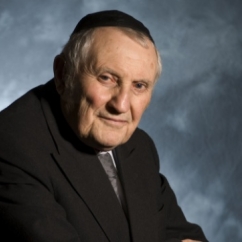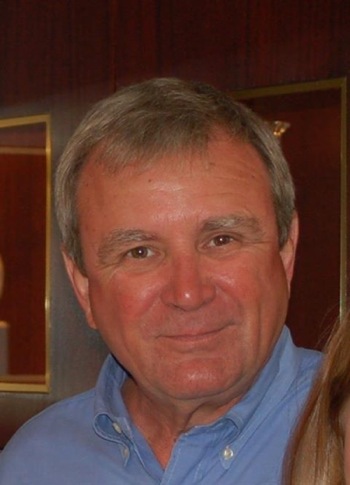Articles and News
In Memoriam: Alexander Hasenfeld, Founder of Hasenfeld-Stein, And Jeweler Robert “Bobby” Chance Jr. June 12, 2013 (1 comment)

Alexander Hasenfeld, Noted Diamantaire
New York, NY—Alexander Hasenfeld, founder and president of Hasenfeld-Stein, died June 6. He was 88. He is survived by his wife, Zissy, two sons, Hertz and Ephraim, daughter, Faigy Stein, and numerous grandchildren, great-grandchildren, and great-great grandchildren.
A Holocaust survivor, Hasenfeld (pictured left) was best known for his accomplishments in the diamond industry, but his influence, dedication, and philanthropy touched many around the world.
The following article, from the 60th anniversary edition of the company’s own newsletter in 2009, describes Hasenfeld’s ingenuity at being able to survive not only the Holocaust, but how, upon arriving in the United States, he entered the diamond business and quickly spotted an opportunity that nobody else saw.
Not only was Hasenfeld a survivor of the Nazi death camps, he also was a survivor of shifts in both the global diamond market and the U.S. economy that left other companies decimated. His business philosophy was simple, and one the company adheres to still: no debt.
Here, in excerpted form, is the Hasenfeld-Stein Newsletter article about its founder:
Hasenfeld was born in Satmar, Hungary, the child of religious parents. During World War II, he was sent, together with 16 family members, to Auschwitz, the most notorious Nazi concentration camp. (Only three survived; he was one.) He survived in part by participating in the camp’s underground economy. He worked outside in a munitions factory (where he lost a finger), and sold suits from the Bekleidungkammer, the camp’s garment warehouse, to civilian supervisory personnel. He was paid in cigarettes, the camp currency, and whiskey, hiding the proceeds in his prisoner’s uniform. The price was 150 cigarettes for a suit; 250 cigarettes for a bottle of whiskey.
“Just like in the diamond business, your word was your bond. It was very dangerous, but we had nothing to lose, since we were all very aware that we were brought to the camps with no intentions to be allowed to leave alive,” he said.
On January 18, 1945, Hasenfeld was part of the infamous “death march”, heading west from Auschwitz to Dachau. They walked night and day, with no food, in sub-freezing temperatures. Fewer than half survived. Most froze to death. Others starved. Those who collapsed from exhaustion were shot on the spot and left on the road. When asked how he remembered all these details, his answer was simple, immediate, and chilling: “This isn’t memory. I see the pictures in my mind, every single minute of every day.” What he saw and what he had to overcome were almost impossible to comprehend.
Later, to avoid both the Russian and American forces fast closing in, they were marched again from Dachau east to the Austrian border (which by then was already independent). But Austria refused to let them enter. Allied forces were close now. A German lieutenant ordered the prisoners to lie down to be shot (a treatment known as Los Hinlegen) But the lieutenant’s female companion pleaded with him to flee, insisting there wasn’t enough time. So instead, they simply got in his car and drove away. Then others followed. After all these prisoners had been through, all of a sudden they found themselves unguarded… and free.
Hasenfeld immigrated to America in 1948, speaking little English. Like many Jewish transplants from Europe, and at the advice of a man in the rough diamond business in Antwerp (who would become his brother-in-law), he went into diamonds. Shortly afterward, he met his wife, Zissy, who, coincidentally, had lived across the street from him in Hungary. He had known her family, but not her. She, too, was a survivor of Auschwitz.
He paid $300 to learn the basics of diamond cutting. Everything else he learned on his own. Working as a cutter, he soon saw that cutters were a dime a dozen. “Everyone came and sold the same thing,” he says. “I wanted to separate myself from the herd.” So in an effort to get what he calls “every last drop of juice from the stone,” he realized that if certain polished stones on the market were re-cut, he could make extra money. Today, this is standard procedure, but at the time it was almost revolutionary. “If I saw a stone with an imperfection, to leave it there would be a crime,” he said. “If it was an SI stone and I turned it to VVS, I could triple the profit.”
As more imperfect diamonds began coming Hasenfeld’s way, other cutters looked on in wonder as the stones he worked on got bigger and bigger. Eventually they figured out what he was doing. “I had about five or six years’ peace,” he said in 2009. “Then they all emulated me.”
By that time, he had started his own business, but by the mid 1950’s, he couldn’t walk. He had contracted tuberculosis of the spine, most likely from his time in the concentration camps. He was sent to Denver to recover, while his wife helped run the business—and received special permission to enter the Diamond Dealers Club, which at the time banned women. While recuperating in Denver, Hasenfeld continued running his business, making local retail contacts. “I would visit them during the time the doctor allowed me to leave the hospital,” he says. “It started where I could go out for one hour, then it became two, three. So I went straight to the bank to my safe deposit box, and then I visited my customers.” He did the rest of the transactions from his hospital bed.
In the 1950s, his was one of a handful of diamond companies to explore what was then new territory: Asia. The first country he visited was Japan. After finding an interpreter he clicked with—he “spoke English better than I did,” Hasenfeld says—he brought the man into the business, even giving him commissions on those transactions he translated.
For a time, Hasenfeld’s company, Hasenfeld-Stein (Stein is his son-in-law), was America’s second-largest diamond exporter. Eventually his sons followed him into the business, but first he insisted they all get MBAs. Yet Hasenfeld runs his business in a way they don’t teach in business school, but probably should: with a minimum of debt. “I never borrowed money in order to buy goods,” he said. The firm always stretched as far as capital allowed, but never beyond, and Hasenfeld’s banker said he was only client whose DTC sight never had to be financed.
That turned out to be the company’s salvation during the great market crash in the early 1980s. “In those days people went bankrupt because the interest rate was 18 percent,” he noted. “We didn’t grab every last dollar. We always made sure our customers earned a profit.” Amid the wreckage of the early 1980s, he saw that it was time to diversify: one son went into real estate, his son-in-law went into insurance. His son Hertz, now vice president of the company, worked with him in diamonds and focused on U.S. retailers.
In 1991 Hasenfeld-Stein became a Diamond Trading Company sightholder, a position the company held until 2008. Hasenfeld was quite philosophical about losing his sight. “It was only 20 to 25 percent of my production, so what did I lose?” he said at the time, noting that, after the advent of Supplier of Choice and its miscellaneous requirements, being a sightholder cost over $1 million a year.
Hasenfeld said his own father taught him to “never be satisfied with what you have. Always try further.” That formed his business philosophy: “You shouldn’t imitate. If you have an idea, try it. If you don’t try, you’ll never know.”
When asked to what he attributes his business success, his answer was to-the-point and immediate: “No debt. No partners.” All the family businesses, including Hasenfeld-Stein, are owned and operated by members of the family.” Quoting the late Harry S. Truman, he said, “The buck stops here.”
While Hasenfeld was extremely philanthropic, supporting a multitude of schools, hospitals, and organizations, one he was particularly proud of was the Jewish Center for Special Education in Brooklyn, NY. Anyone who wishes to make a donation in his memory may call the school at (718) 782-0064.
Robert “Bobby” Chance Jr., Owner of W.R. Chance Diamond Jewelers
Annapolis, MD—Robert “Bobby” Chance Jr. died June 5 at Anne Arundel Medical Center. He was 70. The store, founded in 1949, is a member of the American Gem Society, Jewelers of America, and American Gem Trade Association.

Chance was active in the community his entire life. A 1961 graduate of Annapolis High School, he served in the Maryland National Guard, was a member of the Annapolis Masonic Lodge #89, and was a past patron of the Annapolis O.E.S. Chapter #46. In his spare time, Chance was an avid equestrian and adventurous outdoorsman who loved to ski, sail, hunt, and travel.
Chance is survived by his wife, Jean; mother, Marie; children, Michelle Priddy and Bruce Chance; grandchildren Kyle and Katherine Priddy and Sophie Chance; and sister, Peggy Purdy.







